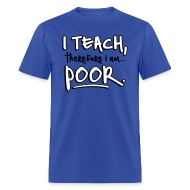Without any further ado, I'll pass it over to Ms. Pinter.
**********************************
In my position at Western Carolina University, I have the
opportunity to teach a freshman seminar entitled “Teachers, School, and
Society,” which explores education and its purpose from many angles. In this
class, I expect the students to develop a strong sense of whether or not
teaching is the right career for them. It is a delicate balance and an
important job—we need teachers and we need a sustainable program. On one hand,
I need to attract as many people into the major as possible; on the other hand,
teaching isn’t for everyone and we want GOOD--no GREAT--teachers in our
nation’s classrooms. We want the kind of teachers who are passionate about what
they do and who have the staying power to invest in the field of education and
make a difference in our schools. To that end, it is my job to outline not only
the good, but also the bad, and the not-so-fun aspects of choosing the teaching
profession. To meet these diverse goals, I structure my course to look at
policy issues, trends and research in education, statistics, teaching
strategies, and the day to day life of an educator.
In my class I expect students to take on the role of both
student/participant and to assume what I refer to as “teacher brain.” Essentially,
as we explore ideas, we do so from the perspective of learning the
instructional practices aimed at teaching for understanding. One of my favorite
activities from this course is a literature circle. Literature circles are a
great choice for an education course because they can be broadly used.
Literature circles cross disciplinary lines as well as grade levels. A
literature circle could work in a high school history class, but also fit the
needs of a fifth grade science class. We first do a mini lesson on what
literature circles are; we explore how to structure literature circles from a
teacher’s perspective-- emphasizing the importance of student choice, structured
facilitation of literature circle meetings, and how to assess student understanding.
I then give students a list of about twenty purposefully
chosen books including professional books and memoirs. We do “book talks” so
that students hear a bit about the content of each choice, then they rank their
top three choices of books. I use Amazon as my choice helper in this task by
choosing a couple books I know, and then let Amazon recommendations do the
rest. This past semester the choices included a wide range of books including Teaching With Love and Logic by Jim Fay
and David Funk for students who are really interested in learning teaching
strategies; The Death and Life of the
Great American School System by Diane Ravitch for students interested in
policy issues in education; Holler if you
Hear Me by Gregory Michie for students interested in teaching in urban
environments; and of course Learn Me Good,
a great choice for students who aren’t leaning in a specific direction, but
want something real, fun, informative, and down to earth.
My most recent class had a large percentage of males, which
was surprising in a predominately female-dominated major. The book Learn Me Good, attracted the attention
of many of the males in the class who formed a tight knit group for our
literature circle experience. The first task of the group is to decide how to
divvy up the responsibilities and reading load. Each group would meet three
times during the month, and each group was individually responsible for
deciding how much to read, what homework they would complete (options are described
below), and who would facilitate each meeting. From a teaching perspective,
this structure is a dream--the work is completely frontloaded so that all the
potential choices help to achieve the goals I want, but the work is totally in
the hands of the students. The requirements and homework choices for students
are the following:
Literature Circle Assignment Options and Descriptions
FOR ALL MEETINGS FOR ALL PARTICIPANTS:
>6 sticky notes for each section of reading
including a variety of text-to-text, text-to-self, and text-to-world
connections. These sticky notes are to be placed on the page to which you are
making a connection. List the page number, what kind of connection you are
making, and a brief description of the connection.
-text to
text: Making a connection between what you are reading in the book and
something else you have read.
-text to
self: Connecting your reading your own personal beliefs and experiences
-text to
world: Connect your reading to something in the outside world (current events,
movies, etc.)
For EACH Literature
circle session, participants must agree on and complete ONE of the following
options:
Journal: Write a
reflective journal about the assigned reading giving thoughts/opinions or
questions regarding what was read.
Picture, Song, or
Poem: choose a specific and relevant scene from this reading assignment and
draw a picture, write song lyrics, or write a poem to match the scene. You must
write a brief caption for your picture, song, or poem explaining the scene and
its importance to the reader and/or the reading assignment.
Character in a Bag:
select a key character or theme/idea from your book and collect artifacts that
match your selection. Write a brief description of why you chose each artifact.
CD Cover: Design
the front and the back cover for a CD to capture the theme or spirit of your
book. Be sure the name of the book, plus the title of the hit single, appears
on the front cover along with an appealing sketch or design. On the back, list
the other songs from the CD, making sure they relate to the book and to the
characters’ experiences.
(These assignments
adapted from Daniels & Steineke, 2004; and Bell, B.H. EDRD 631 at Western
Carolina University)
Here are two sample homework assignments
from this group. The first, a CD cover, has song titles matching the themes in
the book. Students were expected to describe in detail the process for choosing
their titles and to make explicit connections to the text along the way. The
second sample is from the assignment choice “character in a bag.”
The group of students working on Learn Me Good always seemed to have lively conversation. As I
walked around listening to conversations and looking over homework assignments,
I noted a lot of laughter, creativity, and thoughtfulness in much of the work
and conversation. I can only assume that much of the humor and creativity stems
from the content of the book—these students were hooked. The truly rewarding
part was to hear the students branch out beyond the content of the book into
their future classrooms. I would consistently hear, “what do you think about
how he dealt with that?” or “how will you handle that kind of behavior in your
class?”
This experience completely met all of my instructional goals:
students were engaged, thinking deeply about their future teaching, and
learning about an instructional tool to engage their own students down the
road. Having books like Learn Me Good
to give the down and dirty, ups and downs, and all of the fun of classroom
teaching make my job of attracting quality future teachers easier. I refuse to
sugarcoat what these pre-service teachers are getting into. Teaching, while a
noble profession, is far from easy. Learn
Me Good offers students a dose of reality along with some laughter. And
most good teachers know—to do this job well, you have to have a sense of humor!













No comments:
Post a Comment